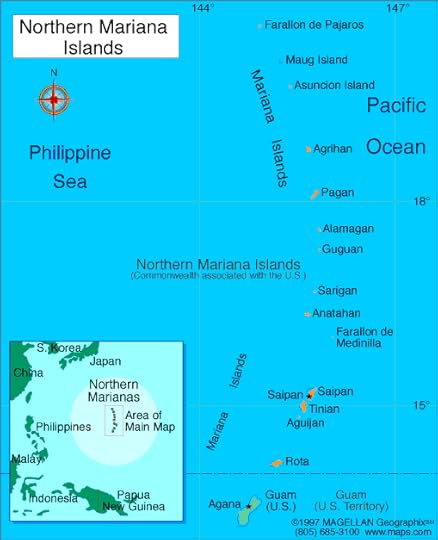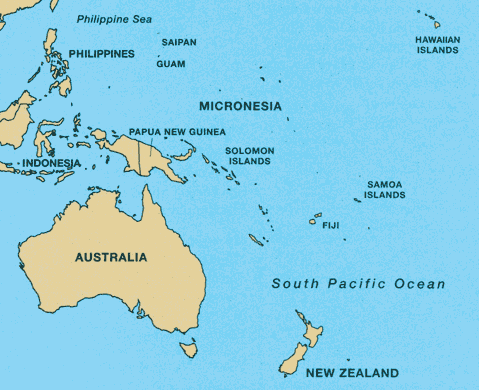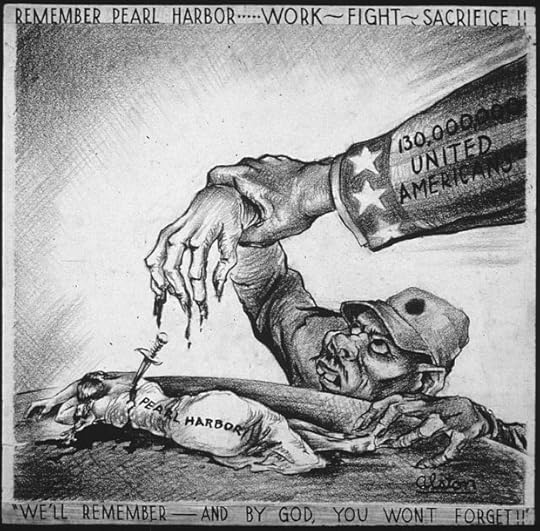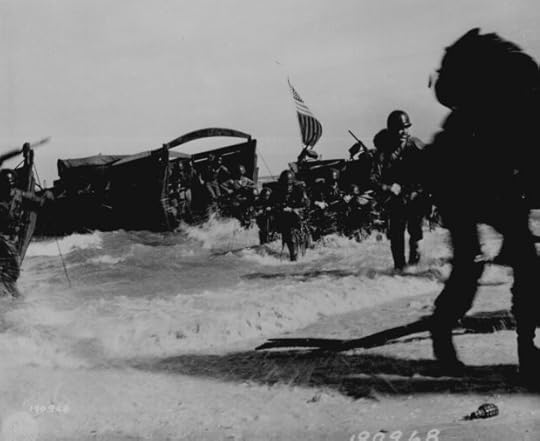Mark Scott Smith's Blog: Enemy in the Mirror, page 95
December 29, 2016
Port Chicago Disaster 1944
In 1944, segregated African-American Navy units were assigned dangerous loading operations. Most of these men were not trained in munitions handling, and safety standards were apparently often overlooked under heavy pressure to complete loading schedules.
In July 1944, a massive explosion occurred during the loading of two adjacent cargo ships at the U.S. Naval magazine at Port Chicago, California. 320 sailors and civilians were killed and 390 injured. Nearly two-thirds of the people killed at Port Chicago were African-American enlisted men.
A month later, when 258 African-American sailors refused to carry out loading orders under conditions they deemed unsafe, 208 received bad conduct discharges and pay forfeiture. The remaining 50 men were court-martialed and sentenced to 8-15 years of hard labor. In 1946, all were granted clemency.
The post Port Chicago Disaster 1944 appeared first on Enemy in the Mirror.
December 26, 2016
Banzai Saipan 1944

In June 1944, U.S. Marines landed on Saipan, the island in the Marianas nearest to the Japanese homeland. The Allied goal was to build an air base for new long-range B-29 bombers that could attack the Japanese home islands.
Japanese resistance was fierce with particularly brutal fighting near Mount Tapotchau, where Marines named the battle sites “Death Valley” and “Purple Heart Ridge.” Ultimately, trapped in the northern part of the island, Japanese soldiers launched the largest Banzai charge of the war with the deaths of ~4,300 Japanese troops. On July 9, Saipan was secured by U.S. forces.
The post Banzai Saipan 1944 appeared first on Enemy in the Mirror.
December 22, 2016
Buzz Bombs – Vergeltungswaffen
Carrying a ton of explosives, the V1 rocket flew at ~400 mph with a range of 200 miles. Launched from the occupied French coast, the first V-1 “Buzzbomb” (Vergeltungswaffen) attacked London on 13 June 1944, immediately after the Allied D-Day invasion.
British countermeasures, including antiaircraft guns, barrage balloons and Hawker Tempest and Gloster Meteor aircraft proved increasingly successful throughout the summer – by August 1944 ~80 per cent of V-1s were being destroyed before hitting their targets.
V-1 attacks on England continued (~100 attacks/day) until October 1944, when the last V-1 launch sites in range of Britain were overrun by the invading Allies. Although difficult to find accurate data, one estimate states ~5,475 people died in V-1 attacks on England.
Beginning in September 1944, Germany sent thousands of V-2 missiles from mobile launch sites against Antwerp and London. These liquid-fueled missiles flew like rocket ships, straight up to the border of space before falling at a terminal speed of 2,386 mph toward their targets. ~1000 V-2’s were fired at Britain before their launch sites were overrun by the advancing Allies. An estimated ~2424 people were killed by V-2s.
Although not particularly accurate, V-1 and V-2 Buzz Bombs achieved their intent – forcing the Allies to commit vast resources in countermeasures and, most important, terrorizing civilians.
The post Buzz Bombs – Vergeltungswaffen appeared first on Enemy in the Mirror.
December 19, 2016
July 1944 Guam

First Battle of Guam – Guam, a U.S. possession in the Mariana islands since the Spanish-American war of 1898, was captured by Imperial Japan in their initial Pacific offensive of December 1941. This first Battle of Guam resulted in 550 Allied and 5900 Japanese deaths.
Second Battle of Guam – From July-August 1944, the Allies waged a bloody campaign to recapture the island. Allied casualties included 1,747 killed and 6,053 wounded. ~ 18,000 Japanese soldiers died.
Although the island was declared secure in August 1945, a number of Japanese soldiers remained at large. In December 1945, several U.S. Marines were ambushed and killed by Japanese soldiers hiding in the jungle. In 1971 Imperial Japanese Army Sergeant Shoichi Yokoi was discovered by hunters after living alone in a cave for 28 years.
The post July 1944 Guam appeared first on Enemy in the Mirror.
December 15, 2016
D-Day – June 1944
On June 6, 1944, >5,000 Allied ships, supported by 13,000 airplanes performed the largest amphibious landing in the history of warfare. Code-named Operation Overlord, the invasion of ~50 miles of beach in Normandy France signaled the beginning of the tough campaign to liberate Nazi-occupied Europe.
By August 1944, northern France was liberated; in June 1945 Nazi Germany surrendered.

The losses on both sides were staggering: 216,000 German and 209,000 Allied troops were killed, wounded or missing during the Battle of Normandy with an additional 16,714 deaths of Allied airmen.
WARNING: this clip from the film Saving Private Ryan is a gruesome, vivid depiction of the landing on Omaha Beach.
The post D-Day – June 1944 appeared first on Enemy in the Mirror.
December 12, 2016
切腹 – Seppuku / Hara-Kiri
Hara-kiri (belly – cut) is a spoken term used by commoners to describe ritual suicide. Seppuku is the written form used amongst higher classes for the same act.
Part of the samurai bushido honor code, seppuku was committed either voluntarily by samurai who preferred to die with honor rather than surrender to their enemies or as capital punishment for samurai who had been shamed or committed serious offenses.
Although Seppuku as judicial punishment was abolished in 1873, many others, encouraged by militaristic propaganda, have subsequently carried it out. This was a common practice among soldiers and civilians choosing death rather than surrender in WWII.
The post 切腹 – Seppuku / Hara-Kiri appeared first on Enemy in the Mirror.
December 8, 2016
1944 Camera Thrills of the War
This American propaganda film made by Castle Films in 1944 emphasizes the “thrill” of war.
Intended to be upbeat and exciting, perhaps motivating enlistment, it captures the spirit of the era.
Although a bit long, it’s worth a look.
The post 1944 Camera Thrills of the War appeared first on Enemy in the Mirror.
December 7, 2016
Pearl Harbor 12/7/41
This scene from the movie Pearl Harbor catches the surprise, shock and horror that led Americans into the war with a burning desire for vengeance. Some historians have suggested that Imperial Japan, failing to anticipate the intensity of this emotion, assumed that the USA would not want to shed more blood in a distant Pacific war and would negotiate a treaty.

Wikimedia Commons
The post Pearl Harbor 12/7/41 appeared first on Enemy in the Mirror.
December 5, 2016
New Guinea 1944

163rd Infantry Regiment landing on Wakde Island, New Guinea, 18 May 1944. (WWIIDatabase)
My late father-in-law Jim Evans fought with the 163rd Infantry Regiment in this campaign. Discussions with him and his comrade Jim Jackson inspired the chapter on the battle of Biak Island in my book Enemy in the Mirror: Love and Fury in the Pacific War.

First Sergeant James Lloyd Evans, U.S. Army.

In April 1944, with the goal of establishing airfields on the northern coast of New Guinea, Allied forces under General Douglas MacArthur attacked Aitape and Hollandia. Expecting an Allied attack further east, the Japanese were taken by surprise. MacArthur’s troops found empty camps with rice still cooking on the stove and abandoned weapons and equipment. The Japanese soon regrouped and counterattacked Aitape in multiple waves. Although these attacks caused heavy Allied casualties, Allied machine guns and artillery decimated the attacking Japanese forces (perhaps ~10,000 men lost) and Aitape and Hollandia were taken.
In May, MacArthur’s troops landed on Wakde island with little beachhead resistance. Advancing inland, however, they soon met the same fierce defense they’d experienced at Aitape. Although the island was taken, Allied troops were still fighting residual Japanese forces on Wakde at the end of the war.
At the end of May 1944, MacArthur’s troops invaded Biak island. Again light resistance at the beachhead foreshadowed heavy resistance inland. An excellent defense plan that properly utilized terrain, numerous caves and tanks (unusual at that time in the Pacific War) was devised by Lieutenant Colonel Naoyuki Kuzume. Although effective for a month, Kuzume’s defenses were finally breached and he committed Seppuku (ritual suicide) in his subterranean command post. Undaunted, Japanese troops in the remaining caves continued to fight. Stymied by the hit-and-run tactics of cave dwelling enemy troops, the Allies resorted to dynamiting caves that held hidden defenders. Biak Island was finally secured at the end of July 1944.
The post New Guinea 1944 appeared first on Enemy in the Mirror.
December 1, 2016
U.S. Economy 1944
In 1942, the Office of Economic Stabilization (OES) was created to combat rising inflation. Under this mandate, the OES controlled the allocation of scarce raw materials for wartime industrial production.
In May 1943, the Office of War Mobilization (OWM) was established to coordinate all government agencies (including the OES) involved in the war effort.

Overcoming initial problems, the U.S. government became quite successful in coordinating the wartime economy. In 1944 American factories produced twice as much war material for the Allies as the entire Axis.
The post U.S. Economy 1944 appeared first on Enemy in the Mirror.
Enemy in the Mirror
I began by posting events around the turn This website www.enemyinmirror.com explores the consciousness, diplomacy, emotion, prejudice and psychology of 20th Century America and her enemies in wartime.
I began by posting events around the turn of the 20th century as I was researching my first novel about the Pacific War. I continued through WWII for my second novel about the Battle of the Atlantic. Now I am beginning to look at the Cold War as I gather information for my next novel about the Korean War. ...more
- Mark Scott Smith's profile
- 7 followers



